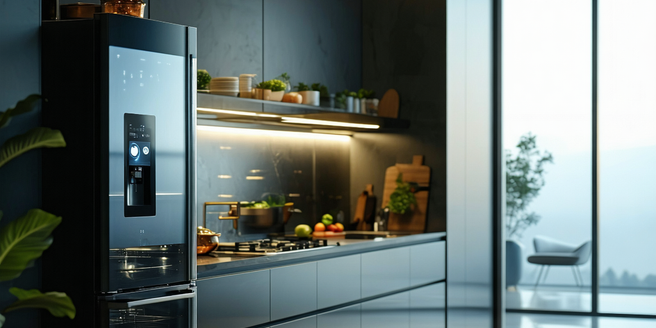Home Appliances: Convergence With Smart Tech

The Evolution of Smart Home Appliances
Over the past decade, home appliances have undergone a technological revolution, seamlessly integrating with smart technology. Initially, these appliances were standalone devices, designed to perform specific functions without any connectivity. However, advancements in IoT (Internet of Things) technology have facilitated the evolution of ordinary devices into smart appliances capable of interacting with other devices and accessing the internet. This transformation has not only enhanced their functionality but has also made them an integral part of smart home ecosystems. The transition from basic automation to sophisticated interoperability has been driven by consumer demand for convenience and efficiency, as well as the desire for greater control over household environments. With continuous technological development, smart home appliances are becoming more intuitive, offering tailored solutions and personalized experiences to users.
Features Driving the Smart Appliance Trend
Smart appliances offer a variety of features that are fueling their adoption and popularity. Connectivity is a cornerstone feature, enabling users to control and monitor appliances remotely via smartphones or voice commands. Integration with virtual assistants, such as Amazon Alexa or Google Assistant, allows for seamless operation using voice commands, enhancing user convenience. Energy management features, including power usage monitoring and optimization, help users reduce energy consumption and costs. Diagnostics and maintenance alerts sent directly to smartphones redefine user experiences, ensuring proactive care and longevity of appliances. Furthermore, AI and machine learning capabilities personalize interactions by learning user habits, providing recommendations for improved efficiency. These features, combined with sleek, modern designs, make smart appliances an attractive option for tech-savvy consumers looking to simplify and enhance their home environments.
Energy Efficiency and Smart Technology
Energy efficiency is a key consideration for consumers when choosing home appliances, and smart technology is playing a pivotal role in optimizing energy use. Many smart appliances are designed to consume less power and operate more efficiently, providing both economic and environmental benefits. Features such as energy consumption tracking enable users to monitor and manage the energy usage of their devices in real-time, leading to informed decisions that can reduce electricity bills. Scheduling capabilities allow devices to run during off-peak hours when energy costs are lower. Furthermore, smart refrigerators, dishwashers, and washing machines use sensors to adjust cycles based on load sizes and needs, ensuring minimal energy waste. This strategic integration of smart technology in appliance design not only meets evolving consumer needs but also supports global sustainability efforts in reducing carbon footprints.
How Smart Appliances Enhance Convenience
Smart appliances are revolutionizing home life by enhancing convenience and simplifying daily tasks. They offer innovative functionalities that save time and effort, allowing users to manage their household chores more efficiently. For instance, smart ovens can be preheated on the way home via a smartphone app, ensuring a seamless transition from task to task. Refrigerators with internal cameras let users inspect contents while shopping, avoiding unnecessary purchases. Robotic vacuum cleaners programmed to clean at scheduled times keep floors spotless with minimal user intervention. These appliances also deliver peace of mind, with features like remote monitoring and notifications that inform users of potential issues. By enabling automation and remote control, smart appliances free up time for consumers to focus on more important aspects of their lives, embodying convenience in the digital age.
Integration and Compatibility in Smart Homes
The smart home ecosystem thrives on the integration and compatibility of various devices and appliances. Seamless interaction between smart appliances and home networks enables centralized control, streamlining the user experience. Connectivity standards such as Wi-Fi, Bluetooth, and Zigbee facilitate communication between devices, ensuring they work harmoniously together. Compatibility with smart home platforms such as Apple HomeKit, Google Home, and Amazon Alexa is crucial for allowing devices from different manufacturers to function cohesively. This interoperability extends to smart lighting, security systems, thermostats, and more, delivering a comprehensive, unified control system. As manufacturers continue to embrace open standards and collaborate on cross-device compatibility, consumers enjoy enhanced flexibility in customizing and upgrading their smart homes, allowing for a tailored experience that evolves with technological advancements.
Future Trends in Smart Home Appliances
The future of smart home appliances is promising, with several trends set to shape the landscape. Artificial intelligence will likely enhance personalization features, understanding user preferences and automating tasks more intuitively. Advancements in machine learning will enable devices to anticipate needs, offering proactive solutions before they are requested. The rise of 5G connectivity will provide faster, more reliable internet connections, enabling real-time interactivity and control of appliances from virtually anywhere. Additionally, sustainability will continue to drive innovation, with companies focusing on eco-friendly materials and energy-efficient designs. As the smart home ecosystem grows, enhanced cybersecurity measures will become imperative to protect user data and privacy. These trends indicate a future where smart appliances not only cater to the immediate needs of consumers but also contribute positively to environmental and societal well-being.